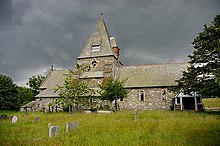St Peter's Church, Finsthwaite
| St Peter's Church, Finsthwaite | |
|---|---|
 St Peter's Church, Finsthwaite, from the north | |
| 54°16′56″N 2°58′16″W / 54.2821°N 2.9711°W | |
| OS grid reference | SD 369,878 |
| Location | Finsthwaite, Cumbria |
| Country | England |
| Denomination | Anglican |
| Website | http://www.finsthwaitechurch.uk/ |
| History | |
| Status | Parish church |
| Dedication | Saint Peter |
| Architecture | |
| Functional status | Active |
| Heritage designation | Grade II* |
| Designated | 23 July 1987 |
| Architect(s) | Paley and Austin |
| Architectural type | Church |
| Style | Romanesque Revival |
| Groundbreaking | 1873 |
| Completed | 1874 |
| Specifications | |
| Materials | Stone rubble with sandstone dressings Slate roof |
| Administration | |
| Province | York |
| Diocese | Carlisle |
| Archdeaconry | Windermere |
| Deanery | Leven Valley |
| Parish | Finsthwaite |
| Clergy | |
| Vicar(s) | Revd Canon Peter Noel Calvert |
St Peter's Church is in the village of Finsthwaite, Cumbria, England. It is an active Anglican parish church in the deanery of Windermere, the archdeaconry of Westmorland and Furness, and the diocese of Carlisle. Formerly part of the Leven Valley benefice, together with St Anne Haverthwaite and St Mary Staveley-in-Cartmel, it is now part of the Cartmel Peninsula Team Ministry.[1] The church is recorded in the National Heritage List for England as a designated Grade II* listed building.[2] St Peter's was designed by the Lancaster partnership of Paley and Austin. They were the winners of a competition to design "mountain chapels" organised by the Carlisle Church Extension Society in 1873. The authors of the Buildings of England series describe the church as "a brilliant essay",[3] and write that "one would have to search far and search long in England to find village churches to vie with" this and two other Austin and Paley churches, Torver and Dolphinholme.[4] The church stands to the southeast of the village.[5]
History
The church was built in 1873–74 to replace a chapel dating from 1724 to 1725. It was paid for by Thomas Newby Wilson of Newby Bridge, the proprietor of the Stott Park Bobbin Mill.[3] The church provided seating for 200 people, and cost £4,170 (equivalent to £640,000 in 2023).[6][7]
Architecture
Exterior
The church is constructed in coursed stone rubble with sandstone dressings. It has a slate roof and tiles on the ridges.[2] Its architectural style is Norman.[8] The plan consists of a four-bay nave, a north porch and a chancel. Between the nave and chancel is a tower. To the north of the tower are an organ chamber and a vestry. Along the side of the nave are round-headed lancet windows. At the west end are two windows, with a lancet window above them. The porch is timber framed on stone walls and has a gable. It leads to the round-headed entrance to the church. On the north and south sides of the tower are buttresses, and between them are projections. In the south projection is a lancet window, with a small window above it. There are two windows in the vestry. At the east end of the chancel are three windows, the central one being wider than the others and a lancet window above them. On the gable of the east end is a cross finial. There are two windows on the south side of the chancel. On the upper part of the tower is a diamond-shaped clock face. The tower has a high pyramidal roof. On the north and south sides of the roof are louvred dormer windows, and on the east and west sides are stone dormers containing round-headed louvred bell openings.[2]
Interior
The ceiling is painted with scrollwork, and with angels carrying copies of the Beatitudes. Around the nave and window arches are a stencilled frieze, part of which has been covered with whitewash.[2] The reredos is made from alabaster and mosaic, it dates from 1883, and was made by Salviati. The rest of the furnishings were designed by the architects. These include the altar rails, the chancel floor, the pulpit, the lectern, and the font, which is made from fossiliferous marble. There is stained glass in the east and west windows by Shrigley and Hunt, that in the west windows containing musical quotations from Handel's Messiah.[3] The two-manual organ was made by Jardine and company of Manchester in 1875.[9]
See also
- Grade II* listed buildings in South Lakeland
- Listed buildings in Colton, Cumbria
- List of ecclesiastical works by Paley and Austin
- Plan of Finsthwaite Churchyard
References
- ^ St Peter, Finsthwaite, Church of England, retrieved 11 June 2011
- ^ a b c d Historic England, "St Peter's Church, Colton (1225177)", National Heritage List for England, retrieved 23 June 2012
- ^ a b c Hyde, Matthew; Pevsner, Nikolaus (2010) [1967], Cumbria, The Buildings of England, New Haven and London: Yale University Press, pp. 347–348, ISBN 978-0-300-12663-1
- ^ Pevsner, Nikolaus (1969). North Lancashire. The Buildings of England. Harmondsworth: Penguin. p. 33. ISBN 0300096178.
- ^ Finsthwaite, Streetmap, retrieved 11 June 2011
- ^ UK Retail Price Index inflation figures are based on data from Clark, Gregory (2017), "The Annual RPI and Average Earnings for Britain, 1209 to Present (New Series)", MeasuringWorth, retrieved 7 May 2024
- ^ Brandwood, Geoff; Austin, Tim; Hughes, John; Price, James (2012), The Architecture of Sharpe, Paley and Austin, Swindon: English Heritage, p. 227, ISBN 978-1-84802-049-8
- ^ Price, James (1998), Sharpe, Paley and Austin: A Lancaster Architectural Practice 1836–1942, Lancaster: Centre for North-West Regional Studies, p. 82, ISBN 1-86220-054-8
- ^ "NPOR [N10947]", National Pipe Organ Register, British Institute of Organ Studies, retrieved 2 July 2020

